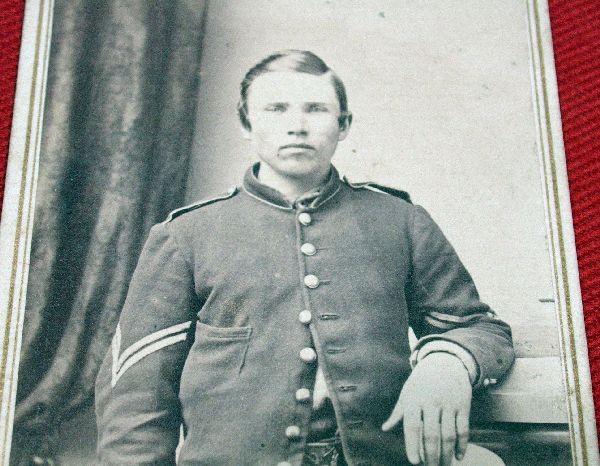George Gick, Jr. served during the Civil War. He enlisted as a private on September 27, 1861 at the age of 18 in Saratoga Springs, New York, mustering into the 77th Regiment (the "Bemis Heights Regiment") of the NY State Volunteer Infantry, Company E, on November 23, 1861. By December 25, 1862 he was promoted to the rank of corporal.
Gick was wounded twice (May 6 and September 19, 1864)and rose to the rank of corporal. He was discharged on December 15, 1864 at Philadelphia, PA.
In March, 1862, with the same brigade, the 77th became a part of Smith's division, 4th corps. It was active at Yorktown, Williamsburg, Mechanicsville and in the Seven Days' battles, and in May was assigned to the 3d brigade, 2nd division, 6th corps with which it served throughout the war. After a short time in camp at Harrison's landing, the regiment entered upon the Maryland campaign; was present at Crampton's gap and met its first heavy loss at Antietam, where 32 were killed, wounded or missing.
Moving by slow stages, the troops reached Fredericksburg in time for the battle but were not assigned to a prominent position. At Chancellorsville the regiment joined in the gallant and successful assault on Marye's heights and lost 83 in killed, wounded and missing.
At Gettysburg it was not closely engaged and proceeded from that battlefield to Fairfield, Pa., Antietam, Marsh Run, Funkstown, Williamsport and Chantilly. It shared in the capture of prisoners made by the 6th corps at Rappahannock Station in November, and participated in the Mine Run fiasco. During December and January a large number of the 77th reenlisted and the regiment took the field at the opening of the Wilderness campaign with many new recruits.
At Wilderness,VA, 66 were reported killed, wounded or missing, and in the remaining days of that week the loss of 107 was suffered by the regiment in the close fighting at Spottsylvania and other points in the immediate vicinity. The regiment was also active at Cold Harbor, then moved with the 6th corps to Petersburg and served in the trenches until July, when the corps was hurried to Washington and met Gen. Early at Port Stevens, with a loss of 20 men.
After discharge, Corporal George Gick, Jr. eventually became a police officer of the New York City Police. However, he had to retire from the police force as he slowly became insane due to the horrors of the "War of the Great Rebellion." On October 17, 1894, his daughter, Susan, and her husband, Frederick William Ruppert, Sr. (son of Franz Ruppert and Susan's aunt, Sophia Gick Ruppert) petitioned the court declaring him insane. George was admitted to the Bloomingdale Asylum for the Insane located in White Plains (now known as the New York Hospital-Cornell Medical Center, Westchester Division) on April 5, 1893, the year the hospital opened at its new facility and location as it was formerly located, since 1868, on Bloomingdale Road (now Broadway) at 115th Street in the Harlem Heights area of Manhattan (now Columbia University).
He was discharged on April 10, 1895 with a diagnosis of "unimproved" with his remaining years unknown to the family to this day.
George Gick, Jr. served during the Civil War. He enlisted as a private on September 27, 1861 at the age of 18 in Saratoga Springs, New York, mustering into the 77th Regiment (the "Bemis Heights Regiment") of the NY State Volunteer Infantry, Company E, on November 23, 1861. By December 25, 1862 he was promoted to the rank of corporal.
Gick was wounded twice (May 6 and September 19, 1864)and rose to the rank of corporal. He was discharged on December 15, 1864 at Philadelphia, PA.
In March, 1862, with the same brigade, the 77th became a part of Smith's division, 4th corps. It was active at Yorktown, Williamsburg, Mechanicsville and in the Seven Days' battles, and in May was assigned to the 3d brigade, 2nd division, 6th corps with which it served throughout the war. After a short time in camp at Harrison's landing, the regiment entered upon the Maryland campaign; was present at Crampton's gap and met its first heavy loss at Antietam, where 32 were killed, wounded or missing.
Moving by slow stages, the troops reached Fredericksburg in time for the battle but were not assigned to a prominent position. At Chancellorsville the regiment joined in the gallant and successful assault on Marye's heights and lost 83 in killed, wounded and missing.
At Gettysburg it was not closely engaged and proceeded from that battlefield to Fairfield, Pa., Antietam, Marsh Run, Funkstown, Williamsport and Chantilly. It shared in the capture of prisoners made by the 6th corps at Rappahannock Station in November, and participated in the Mine Run fiasco. During December and January a large number of the 77th reenlisted and the regiment took the field at the opening of the Wilderness campaign with many new recruits.
At Wilderness,VA, 66 were reported killed, wounded or missing, and in the remaining days of that week the loss of 107 was suffered by the regiment in the close fighting at Spottsylvania and other points in the immediate vicinity. The regiment was also active at Cold Harbor, then moved with the 6th corps to Petersburg and served in the trenches until July, when the corps was hurried to Washington and met Gen. Early at Port Stevens, with a loss of 20 men.
After discharge, Corporal George Gick, Jr. eventually became a police officer of the New York City Police. However, he had to retire from the police force as he slowly became insane due to the horrors of the "War of the Great Rebellion." On October 17, 1894, his daughter, Susan, and her husband, Frederick William Ruppert, Sr. (son of Franz Ruppert and Susan's aunt, Sophia Gick Ruppert) petitioned the court declaring him insane. George was admitted to the Bloomingdale Asylum for the Insane located in White Plains (now known as the New York Hospital-Cornell Medical Center, Westchester Division) on April 5, 1893, the year the hospital opened at its new facility and location as it was formerly located, since 1868, on Bloomingdale Road (now Broadway) at 115th Street in the Harlem Heights area of Manhattan (now Columbia University).
He was discharged on April 10, 1895 with a diagnosis of "unimproved" with his remaining years unknown to the family to this day.
Advertisement
Explore more
Sponsored by Ancestry
Advertisement



